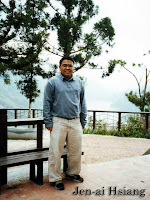 Since we had been in Taichung the whole time and usually did nothing during the day, our Taiwanese guide Frank, who worked with the MECO office in Taichung, arranged for a van to take us to this place he called "snowy mountain." We didn't know where exactly we were going since all the names were in Mandarin. But since we were yearning to go around, we said yes. The trip took several hours along the Central Cross-Island Highway or Route 8. I also distinctly remember that we wasted so much time because of a flat tire!
Since we had been in Taichung the whole time and usually did nothing during the day, our Taiwanese guide Frank, who worked with the MECO office in Taichung, arranged for a van to take us to this place he called "snowy mountain." We didn't know where exactly we were going since all the names were in Mandarin. But since we were yearning to go around, we said yes. The trip took several hours along the Central Cross-Island Highway or Route 8. I also distinctly remember that we wasted so much time because of a flat tire! On the way, our group paid a courtesy call to Mr. Yukan Nafu, chief of Jen-ai Hsiang (Ren-ai Township) in Nantou County. The place reminded me so much of our laidback mountain towns in the Cordilleras. The mountain climate was very pleasing to the senses. It's sad Baguio City air is no longer as clean as it used to be and you really have to go into the rural areas to enjoy nature at its finest.
On the way, our group paid a courtesy call to Mr. Yukan Nafu, chief of Jen-ai Hsiang (Ren-ai Township) in Nantou County. The place reminded me so much of our laidback mountain towns in the Cordilleras. The mountain climate was very pleasing to the senses. It's sad Baguio City air is no longer as clean as it used to be and you really have to go into the rural areas to enjoy nature at its finest.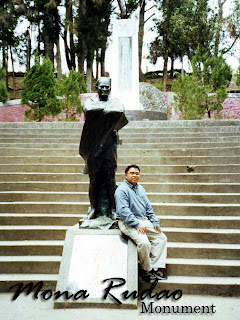 Also in Ren-ai, we dropped by the Mona Rudao Monument, which was erected to honor Mona Rudao, a chief of the Atayal Tribe, who led his tribe people in the Wushe Anti-Japanese Incident.Anyway, it turns out, we were on our way to the highest point on the Taiwan Highway System. Although I know it was somewhere inside the Taroko National Park, it was only after research that I found out that this area was known as Wuling. We took photos in the marker in Hehuanshan Pass, which at 3275 meters above see level is the highest road pass in East Asia.
Also in Ren-ai, we dropped by the Mona Rudao Monument, which was erected to honor Mona Rudao, a chief of the Atayal Tribe, who led his tribe people in the Wushe Anti-Japanese Incident.Anyway, it turns out, we were on our way to the highest point on the Taiwan Highway System. Although I know it was somewhere inside the Taroko National Park, it was only after research that I found out that this area was known as Wuling. We took photos in the marker in Hehuanshan Pass, which at 3275 meters above see level is the highest road pass in East Asia.
 The fog was so thick, it was difficult to see things around. So obviously, the view of the mountains was blocked as well. In fact, it was so cold, it was actually snowing. Near the marker were several makeshift stalls which sold hot meals such as noodles and grilled sausages. It was good someone posted his photos of Wuling so I was able to see the view of the mountains sans the thick fog.
The fog was so thick, it was difficult to see things around. So obviously, the view of the mountains was blocked as well. In fact, it was so cold, it was actually snowing. Near the marker were several makeshift stalls which sold hot meals such as noodles and grilled sausages. It was good someone posted his photos of Wuling so I was able to see the view of the mountains sans the thick fog.
 We didn't stay too long up there since it was freezing cold and there was nothing to see at that time. Winter is not a good time to go up. So the group made its way down the mountain again.
We didn't stay too long up there since it was freezing cold and there was nothing to see at that time. Winter is not a good time to go up. So the group made its way down the mountain again.
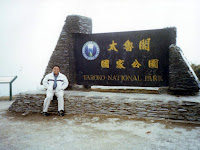 Maybe if I get the chance, I should come back here during the summer months. The brochure of Taroko National Park has very enticing photos of the many natural attractions of the park. We decided to rest early that night since we were going to Taipei the next day.
Maybe if I get the chance, I should come back here during the summer months. The brochure of Taroko National Park has very enticing photos of the many natural attractions of the park. We decided to rest early that night since we were going to Taipei the next day.
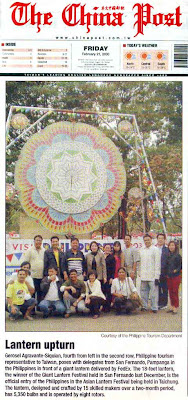 How can one forget the date we left for Taiwan. It was February 14, 2003. The City Government of San Fernando was being sent by the Department of Tourism to represent the country in the 2003 Taiwan Lantern Festival which was held in Taichung. I had previously been to Taiwan when I was five but we only went around Taipei. So this was my first time to get out of the capital city. But time was limited since although we were there for almost two weeks, most of our time was at the festival and meeting with local officials.It was a late night Philippine Airlines flight since I remember, our passports were stamped in Taipei on the 15th. We were met by the Tourism Attache who accompanied us on the two-hour bus to Taichung, Taiwan's culture city. The bus ride was very comfortable since the chairs were really big. It was like sleeping in your own living room. When we arrived in Taichung we all went straight to bed.Most of our time that day was spent at the Taichung branch of the Manila Economic and Cultural Office (MECO), our de facto embassy in Taiwan. That night was the opening of the festival. We had passes but didn't get to use them since we were busy preparing the San Fernando giant lantern.
How can one forget the date we left for Taiwan. It was February 14, 2003. The City Government of San Fernando was being sent by the Department of Tourism to represent the country in the 2003 Taiwan Lantern Festival which was held in Taichung. I had previously been to Taiwan when I was five but we only went around Taipei. So this was my first time to get out of the capital city. But time was limited since although we were there for almost two weeks, most of our time was at the festival and meeting with local officials.It was a late night Philippine Airlines flight since I remember, our passports were stamped in Taipei on the 15th. We were met by the Tourism Attache who accompanied us on the two-hour bus to Taichung, Taiwan's culture city. The bus ride was very comfortable since the chairs were really big. It was like sleeping in your own living room. When we arrived in Taichung we all went straight to bed.Most of our time that day was spent at the Taichung branch of the Manila Economic and Cultural Office (MECO), our de facto embassy in Taiwan. That night was the opening of the festival. We had passes but didn't get to use them since we were busy preparing the San Fernando giant lantern.
 Anyway, when our work was done, I checked if I could still catch the program. But when I got close to the stage, President Chen Shui-bian was about to leave. I was just about a meter or two away but because of tight security, I wasn't able to have a photo taken with him like I usually do when I get the chance to meet heads of state . Who wouldn't? Oh well!
Anyway, when our work was done, I checked if I could still catch the program. But when I got close to the stage, President Chen Shui-bian was about to leave. I was just about a meter or two away but because of tight security, I wasn't able to have a photo taken with him like I usually do when I get the chance to meet heads of state . Who wouldn't? Oh well!
On the right is the main lantern that was lit by President Chen. I remember that the NT$10 million (US$287,356) spent by Chunghua Telecom to produce this 20-meter lantern was the talk of the town during the festival.
 We only got to go around Taichung on the 17th and 18th. I remember walking around Taichung Park, also known as Zhong Shan Park. Its main attraction is Jih-Yueh Lake which was originally a natural pond. After years of human modifications, it now covers an area of about 13,500 square meters. In the middle of the lake is a pavillion built in 1908 to commemorate the completion of the north-south railway when the island was still under Japanese occupation. This pavilion has become an important symbol of the city.
We only got to go around Taichung on the 17th and 18th. I remember walking around Taichung Park, also known as Zhong Shan Park. Its main attraction is Jih-Yueh Lake which was originally a natural pond. After years of human modifications, it now covers an area of about 13,500 square meters. In the middle of the lake is a pavillion built in 1908 to commemorate the completion of the north-south railway when the island was still under Japanese occupation. This pavilion has become an important symbol of the city.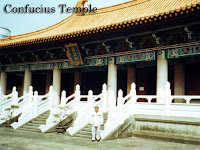 It was while reading on the Japanese rule in Taiwan that I found out that the Republica Filipina was not the first Asian republic as some would claim, but was predated by the Republic of Formosa (May 24, 1895) and the Republic of Ezo in Japan (December 25, 1868) among others. In fact, according to Wikipedia, the first republics in Asia are Vaishali, Licchavi and Vajji all established in India circa 600 B.C.
It was while reading on the Japanese rule in Taiwan that I found out that the Republica Filipina was not the first Asian republic as some would claim, but was predated by the Republic of Formosa (May 24, 1895) and the Republic of Ezo in Japan (December 25, 1868) among others. In fact, according to Wikipedia, the first republics in Asia are Vaishali, Licchavi and Vajji all established in India circa 600 B.C. The next day, we visited the Confucius Temple. According to the Taichung website "Taichung's peaceful Confucius Temple features impressive, rectangular Sung Dynasty-style structures, surrounded by spacious courtyards and a garden. The buildings and grounds are usually quiet and near-deserted, giving the temple a relaxing, meditative air. Once a year, during Confucius' birthday (Teachers' Day), the temple comes to life for a dawn ceremony featuring processions of marchers and musicians clad in traditional Chinese imperial court costumes, government officials and hundreds of spectators." Beside it is the Martyrs Shrine. But we weren't able to go inside since it's closed on weekdays.
The next day, we visited the Confucius Temple. According to the Taichung website "Taichung's peaceful Confucius Temple features impressive, rectangular Sung Dynasty-style structures, surrounded by spacious courtyards and a garden. The buildings and grounds are usually quiet and near-deserted, giving the temple a relaxing, meditative air. Once a year, during Confucius' birthday (Teachers' Day), the temple comes to life for a dawn ceremony featuring processions of marchers and musicians clad in traditional Chinese imperial court costumes, government officials and hundreds of spectators." Beside it is the Martyrs Shrine. But we weren't able to go inside since it's closed on weekdays.
 We also got to visit the Paochueh Temple, a Buddhist temple in the northern edge of the city which is known for its big Buddha statue. The 88-foot gold statue is a big-bellied, happy Buddha known as Maitreya. Below it is an inscription which translates "Happiness to All."
We also got to visit the Paochueh Temple, a Buddhist temple in the northern edge of the city which is known for its big Buddha statue. The 88-foot gold statue is a big-bellied, happy Buddha known as Maitreya. Below it is an inscription which translates "Happiness to All."
The temple complex is a quiet and secluded place where one can reflect and meditate. The main shrine hall, with a striking blue glazed roof, was built in 1928 and houses three Buddha images protected by a row of fierce guardians.
 That afternoon, we also made a courtesy call to Mr. Chen Tien-Wen, the Vice Speaker of the Taichung City Council at the historic Taichung City Hall. It was commissioned in 1912 as the Taichung State Building by the Japanese colonial government. This wood and re-inforced brick structure was completed in 1924 and is considered one of the most elaborate and ornate buildings of the Japanese colonial period in Taiwan.
That afternoon, we also made a courtesy call to Mr. Chen Tien-Wen, the Vice Speaker of the Taichung City Council at the historic Taichung City Hall. It was commissioned in 1912 as the Taichung State Building by the Japanese colonial government. This wood and re-inforced brick structure was completed in 1924 and is considered one of the most elaborate and ornate buildings of the Japanese colonial period in Taiwan.
That's it for Taichung. Up next is the day trip to the mountains in Nantou County we did the day after.
Heritage watch
■ Chinese boat loaded with stuffed sea turtles released
■ Legal eagles to help prosecute Tubbataha reef poachers
■ Legal team formed to help prosecute Chinese poachers
■ Chinese envoy’s letter led to suspected poachers’ release
■ Chinese gov’t pressed RP to free Tubbataha poachers
This is a very sad issue for the Philippines. It just shows how weak our government is in protecting our natural heritage. It also shows how other nations condone the illegal acts of their citizens.
■ Lost but not forgotten lighthouse
■ Pila townsfolk preserve heritage town
Here is some good news for everyone. I hope other localities follow Pila's example.
■ Historic church, houses fill Laguna town’s coffers
■ Restoring Dagupan’s most treasured heritage
To those asking about what one can do in Manila while in transit and waiting for their flight out, here is a suggestion: Go to the SM Mall of Asia!Ton, my SSEAYP SG-mate from Thailand, was in Cebu the past few days for the 12th ASEAN Summit being part of their Ministry of Foreign Affairs. It was all work for him and he didn't get to see much, just Shangri-La Mactan, Cebu Midtown and the CICC as well as the sights along the way. To add to that, he only had three hours in Manila today from the time his PAL flight arrived in the NAIA Centennial Terminal 2 to the time his Thai Airways flight left the NAIA Terminal 1. So Pam, my SG-mate from the Philippines, and I played it by ear and met up with him at Terminal 2. The vehicle from the Thai Embassy was there to bring their group to Terminal 1. So we joined them in the van.We found out that they were having lunch at the SM Mall of Asia after they checked their luggage in. Good news, since at least we get to have lunch with Ton. So we waited outside until I received a phone call from Ton that they had left Terminal 1 from the VIP level of the arrival area which I had forseen since obviously, the vehicle had diplomatic plates. Haha! We had no choice but to take a taxi to SM Mall of Asia.The trip was less than 20 minutes and we spent PHP75 for the taxi. If you are a passenger in transit and want to save on a cab since the airport taxi is costly, go to the departure area and sneak into one of the taxis that had just unloaded its passengers. Hehe!
So Pam, my SG-mate from the Philippines, and I played it by ear and met up with him at Terminal 2. The vehicle from the Thai Embassy was there to bring their group to Terminal 1. So we joined them in the van.We found out that they were having lunch at the SM Mall of Asia after they checked their luggage in. Good news, since at least we get to have lunch with Ton. So we waited outside until I received a phone call from Ton that they had left Terminal 1 from the VIP level of the arrival area which I had forseen since obviously, the vehicle had diplomatic plates. Haha! We had no choice but to take a taxi to SM Mall of Asia.The trip was less than 20 minutes and we spent PHP75 for the taxi. If you are a passenger in transit and want to save on a cab since the airport taxi is costly, go to the departure area and sneak into one of the taxis that had just unloaded its passengers. Hehe! We only had an hour to go around and eat lunch. So we rushed to find the first Filipino restaurant we saw. The name of the place was Bangus. Since Ton wanted pork, we ordered sisig, crispy pata, and chicken and pork adobo, as well as garlic rice. He enjoyed the sisig but found the adobo quite salty. Same reaction here, their adobo was quite salty. We got to walk around a bit after but not too far since we had to be in the van by 1 p.m. So much for my first visit to the SM Mall of Asia! Haha! Sad to say it was my first visit too. Haha!Anyway, I haven't really traveled much these past few weeks. I regret not going out of town during the Christmas break since now, school, work, the Senate meetings on the proposed Heritage Bill, as well as meetings for the Ateneo Alumni Association have occupied most of my time. So in the meantime, I'll write about my trip to Taiwan, also in 2003.
We only had an hour to go around and eat lunch. So we rushed to find the first Filipino restaurant we saw. The name of the place was Bangus. Since Ton wanted pork, we ordered sisig, crispy pata, and chicken and pork adobo, as well as garlic rice. He enjoyed the sisig but found the adobo quite salty. Same reaction here, their adobo was quite salty. We got to walk around a bit after but not too far since we had to be in the van by 1 p.m. So much for my first visit to the SM Mall of Asia! Haha! Sad to say it was my first visit too. Haha!Anyway, I haven't really traveled much these past few weeks. I regret not going out of town during the Christmas break since now, school, work, the Senate meetings on the proposed Heritage Bill, as well as meetings for the Ateneo Alumni Association have occupied most of my time. So in the meantime, I'll write about my trip to Taiwan, also in 2003.
 Since we had been in Taichung the whole time and usually did nothing during the day, our Taiwanese guide Frank, who worked with the MECO office in Taichung, arranged for a van to take us to this place he called "snowy mountain." We didn't know where exactly we were going since all the names were in Mandarin. But since we were yearning to go around, we said yes.
Since we had been in Taichung the whole time and usually did nothing during the day, our Taiwanese guide Frank, who worked with the MECO office in Taichung, arranged for a van to take us to this place he called "snowy mountain." We didn't know where exactly we were going since all the names were in Mandarin. But since we were yearning to go around, we said yes.  On the way, our group paid a courtesy call to Mr. Yukan Nafu, chief of Jen-ai Hsiang (Ren-ai Township) in Nantou County. The place reminded me so much of our laidback mountain towns in the Cordilleras. The mountain climate was very pleasing to the senses. It's sad Baguio City air is no longer as clean as it used to be and you really have to go into the rural areas to enjoy nature at its finest.
On the way, our group paid a courtesy call to Mr. Yukan Nafu, chief of Jen-ai Hsiang (Ren-ai Township) in Nantou County. The place reminded me so much of our laidback mountain towns in the Cordilleras. The mountain climate was very pleasing to the senses. It's sad Baguio City air is no longer as clean as it used to be and you really have to go into the rural areas to enjoy nature at its finest. Also in Ren-ai, we dropped by the Mona Rudao Monument, which was erected to honor Mona Rudao, a chief of the Atayal Tribe, who led his tribe people in the Wushe Anti-Japanese Incident.
Also in Ren-ai, we dropped by the Mona Rudao Monument, which was erected to honor Mona Rudao, a chief of the Atayal Tribe, who led his tribe people in the Wushe Anti-Japanese Incident. The fog was so thick, it was difficult to see things around. So obviously, the view of the mountains was blocked as well. In fact, it was so cold, it was actually snowing. Near the marker were several makeshift stalls which sold hot meals such as noodles and grilled sausages. It was good someone posted his photos of Wuling so I was able to see the view of the mountains sans the thick fog.
The fog was so thick, it was difficult to see things around. So obviously, the view of the mountains was blocked as well. In fact, it was so cold, it was actually snowing. Near the marker were several makeshift stalls which sold hot meals such as noodles and grilled sausages. It was good someone posted his photos of Wuling so I was able to see the view of the mountains sans the thick fog. We didn't stay too long up there since it was freezing cold and there was nothing to see at that time. Winter is not a good time to go up. So the group made its way down the mountain again.
We didn't stay too long up there since it was freezing cold and there was nothing to see at that time. Winter is not a good time to go up. So the group made its way down the mountain again. Maybe if I get the chance, I should come back here during the summer months. The brochure of Taroko National Park has very enticing photos of the many natural attractions of the park. We decided to rest early that night since we were going to Taipei the next day.
Maybe if I get the chance, I should come back here during the summer months. The brochure of Taroko National Park has very enticing photos of the many natural attractions of the park. We decided to rest early that night since we were going to Taipei the next day.









